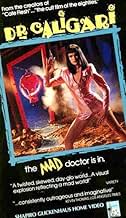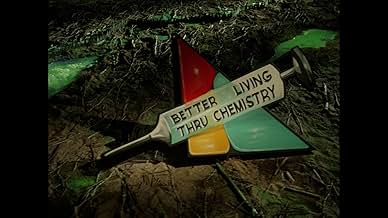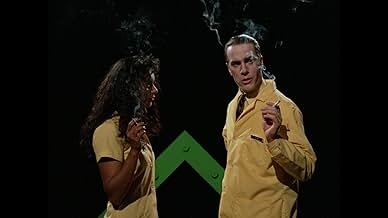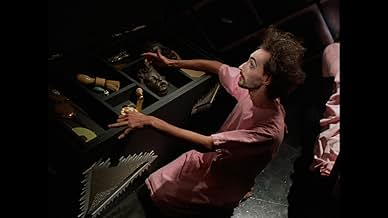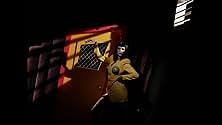NOTE IMDb
6,0/10
1,8 k
MA NOTE
Ajouter une intrigue dans votre langueThe granddaughter of an infamous doctor experiments with hormone and shock therapies at her asylum for the insane.The granddaughter of an infamous doctor experiments with hormone and shock therapies at her asylum for the insane.The granddaughter of an infamous doctor experiments with hormone and shock therapies at her asylum for the insane.
- Réalisation
- Scénario
- Casting principal
Debra De Liso
- Grace Butler
- (as Debra Deliso)
Nina DePonca
- Human Lamp
- (as Vera Butler)
Salvador Espinoza
- Spanish Patient
- (as Salvador R. Espinoza)
- …
Avis à la une
If there was ever an art-house film that existed, this would be it. In other reviews I've discussed the forays into artistic film-making made possible by the Expressionist movement of the 1920's. I've always thought of the 1980's as a decade that served as a revival in its own right, experimenting with abstract and surrealist qualities upon several mediums. Dr. Caligari serves as a possible end of this decade and the experimentation found within. I can discuss topics like New Romanticism from the 80's a bit more in depth but for some of you that might be as interesting as watching water boil.
This film borrows loosely from the original, and I do mean loosely. For one, Caligari is a woman – and hey, change is good – but why is she a sexual deviant? Two, there is mention of an insane asylum much like the 1920 version as well – but that's it. Everything is strewn about in a convoluted, nightmarish heap. Mrs. Van Houten suffers from extreme nymphomania and her husband, Les, seeks possible treatment at the hands of Dr. Caligari. After this small plot detail is established it's basically a free-for-all. There is symbolism portrayed at every turn. You can't make heads or tails of the dialog. Sexual content is found throughout, even more so than violence. The man responsible for the makeup of this film later went on to do the Pirates of the Caribbean trilogy - what an impressive resume he must have! Sexual gratuity wasn't innovative by 1989, but that isn't what makes this film visually comparative to the 1920 silent version.
This film was not shot in black and white, but the stark difference in contrasting colors and lighting techniques are more than similar to the Expressionist output 70 years earlier. This may have served as a point of brilliance had it not been for the sexual ridiculousness that followed. Literally, and I mean literally, everything in this film deals with sex on some level. I really have no idea why they decided to go down that avenue with a film like this – a name which held importance and value in cinema itself! I suppose it's no shock that the director of this version has been responsible for other "artsy" porn films as well, but why on Earth would you choose to dabble with Dr. Caligari? I wasn't offended by the topics explored – just mystified. Was that really the goal here? To take something that held value and make it laughable?
As with all films of this caliber, it has a considerable cult following. If you're an art house fan that doesn't mind trashy, exploitative themes of violence and sexual content, this may be your lucky day. Make no mistake; aside from visual similarities, The Cabinet of Dr. Caligari and Dr. Caligari are two very different films.
This film borrows loosely from the original, and I do mean loosely. For one, Caligari is a woman – and hey, change is good – but why is she a sexual deviant? Two, there is mention of an insane asylum much like the 1920 version as well – but that's it. Everything is strewn about in a convoluted, nightmarish heap. Mrs. Van Houten suffers from extreme nymphomania and her husband, Les, seeks possible treatment at the hands of Dr. Caligari. After this small plot detail is established it's basically a free-for-all. There is symbolism portrayed at every turn. You can't make heads or tails of the dialog. Sexual content is found throughout, even more so than violence. The man responsible for the makeup of this film later went on to do the Pirates of the Caribbean trilogy - what an impressive resume he must have! Sexual gratuity wasn't innovative by 1989, but that isn't what makes this film visually comparative to the 1920 silent version.
This film was not shot in black and white, but the stark difference in contrasting colors and lighting techniques are more than similar to the Expressionist output 70 years earlier. This may have served as a point of brilliance had it not been for the sexual ridiculousness that followed. Literally, and I mean literally, everything in this film deals with sex on some level. I really have no idea why they decided to go down that avenue with a film like this – a name which held importance and value in cinema itself! I suppose it's no shock that the director of this version has been responsible for other "artsy" porn films as well, but why on Earth would you choose to dabble with Dr. Caligari? I wasn't offended by the topics explored – just mystified. Was that really the goal here? To take something that held value and make it laughable?
As with all films of this caliber, it has a considerable cult following. If you're an art house fan that doesn't mind trashy, exploitative themes of violence and sexual content, this may be your lucky day. Make no mistake; aside from visual similarities, The Cabinet of Dr. Caligari and Dr. Caligari are two very different films.
Stephen Sayadian's "Dr. Caligari" (1989) is a phantasmagorical fever dream that plunges viewers into a world more disconcerting and distorted than the distorted sets of its silent film inspiration, "The Cabinet of Dr. Caligari". This film is a testament to the enduring power of German Expressionism, a perverse pastiche of its visual and psychological hallmarks warped through a lens of '80s cult cinema sensibilities.
At the heart of this bizarre spectacle is the asylum of Dr. Caligari's granddaughter, a cold and clinical space saturated with lurid neon colors reminiscent of a warped Dick Tracy comic panel. Here, sexual deviance is not merely a pathology but the very subject of experimentation. The film's psychosexual explorations are brazen and exploitative, channeling a dark, camp energy that borders on the parodic.
Sayadian uses dialogue as a weapon of disorientation. Characters deliver absurdist, stilted lines with unnerving artificiality, their words less meaningful utterances than sonic textures adding to the film's unsettling atmosphere. This mockery of 'arty' pretension contributes to the film's blackly comedic tone, as does the gleeful revelry in its own exploitation.
While some might admire its visual boldness and thematic provocations, "Dr. Caligari" is undeniably a film of extremes. Its blend of jarring style, sexual explicitness, and absurdist humor isn't crafted for a broad audience. Those with stomachs for the bizarre, a taste for the transgressive, and a fondness for the stylistic legacy of German Expressionism will find this film an intoxicating, if deeply flawed, curiosity. It's a warped mirror reflecting both the anxieties and guilty pleasures of its era, a fever dream of psychosexual perversion that remains both repellent and oddly compelling.
At the heart of this bizarre spectacle is the asylum of Dr. Caligari's granddaughter, a cold and clinical space saturated with lurid neon colors reminiscent of a warped Dick Tracy comic panel. Here, sexual deviance is not merely a pathology but the very subject of experimentation. The film's psychosexual explorations are brazen and exploitative, channeling a dark, camp energy that borders on the parodic.
Sayadian uses dialogue as a weapon of disorientation. Characters deliver absurdist, stilted lines with unnerving artificiality, their words less meaningful utterances than sonic textures adding to the film's unsettling atmosphere. This mockery of 'arty' pretension contributes to the film's blackly comedic tone, as does the gleeful revelry in its own exploitation.
While some might admire its visual boldness and thematic provocations, "Dr. Caligari" is undeniably a film of extremes. Its blend of jarring style, sexual explicitness, and absurdist humor isn't crafted for a broad audience. Those with stomachs for the bizarre, a taste for the transgressive, and a fondness for the stylistic legacy of German Expressionism will find this film an intoxicating, if deeply flawed, curiosity. It's a warped mirror reflecting both the anxieties and guilty pleasures of its era, a fever dream of psychosexual perversion that remains both repellent and oddly compelling.
This is definitely one of the strangest alt-indie-freak films I have seen. The characters are almost caricatures, but their actions are choreographed with their lines as they pose around each other.
Madeline Reynard is electrifying as Dr. Caligari, a descendant of the infamous Caligari. She is working on an insidious plot to transfer personality traits between patients in a mental hospital by swapping brain fluids. Her plans go awry when some staff members catch on and she uses a cannibalistic masochist (Shivver Boy) in her experiments.
I definitely recommend this movie for your collection, if not to scare your "normal" friends but for the giant latex tongue.
Madeline Reynard is electrifying as Dr. Caligari, a descendant of the infamous Caligari. She is working on an insidious plot to transfer personality traits between patients in a mental hospital by swapping brain fluids. Her plans go awry when some staff members catch on and she uses a cannibalistic masochist (Shivver Boy) in her experiments.
I definitely recommend this movie for your collection, if not to scare your "normal" friends but for the giant latex tongue.
This movie has all the tastelessness of an early John Waters film coupled with a Dali like surrealism. This is one of my favorite films of all time (which probably speaks volumes about my own mental health). It flaunts modern convention of cinema and social morays both, the doctor is both hateful yet strangely attractive, the way one might stare at a twisted corpse that has been run over by a train. It's horrific, yet we can't take our eyes off of it.
And of course it co-stars the late Fox Harris, known for his portrayal of the creator of the neutron bomb in Repoman as well as the cheesy lounge singer in Straight to Hell, along with a long string of other B-movies.
This movie is not for everyone, but everyone should see it, especially in large groups where you, the enlightened, can watch them and laugh more at their reactions than at the movie itself!
And by the way, Aunt Bea still gives me randy pants!
Chincilla, chincilla, chinchilla!
And of course it co-stars the late Fox Harris, known for his portrayal of the creator of the neutron bomb in Repoman as well as the cheesy lounge singer in Straight to Hell, along with a long string of other B-movies.
This movie is not for everyone, but everyone should see it, especially in large groups where you, the enlightened, can watch them and laugh more at their reactions than at the movie itself!
And by the way, Aunt Bea still gives me randy pants!
Chincilla, chincilla, chinchilla!
This movie is the greatest piece of absurdist cinema ever. Watching is like an intellectual acid trip through the darkest recesses of your brain. The characters are memorable, the dialogue is unforgettable, the scenery is unbelievable, and the whole is greater than even the sum of all these parts. Best line: "Juice me, baby, I'm a shiver junkie." Best character: the cannibalistic pedophile who is addicted to being electrocuted. Best scene: the surrealistic sex scene between the nymphomaniac and the doll-headed man.
Le saviez-vous
- AnecdotesFinal film of Fox Harris.
- ConnexionsFeatures Le Cabinet du docteur Caligari (1920)
Meilleurs choix
Connectez-vous pour évaluer et suivre la liste de favoris afin de recevoir des recommandations personnalisées
Détails
- Durée1 heure 20 minutes
- Couleur
- Mixage
- Rapport de forme
- 1.66 : 1
Contribuer à cette page
Suggérer une modification ou ajouter du contenu manquant



